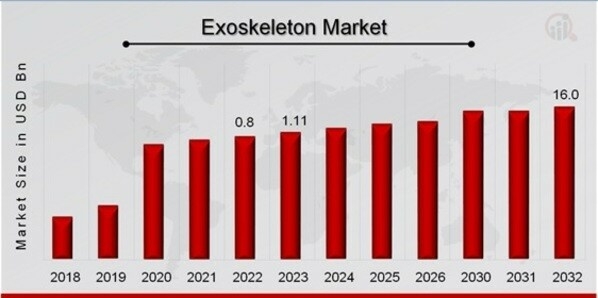Exoskeleton Market A Powerful Force Reshaping Industries
Exoskeleton Market Size was valued at USD 0.8 Billion in 2022. The exoskeleton market industry is projected to grow from USD 1.11 Billion in 2023 to USD 16.0 Billion by 2032, exhibiting a compound annual growth rate (CAGR) of 39.50% during the forecast period (2023 – 2032)
The exoskeleton market is experiencing a period of dynamic growth, driven by technological advancements, increasing workplace safety concerns, and a widening range of applications across various sectors. This article provides a comprehensive overview of the market, exploring its dynamics, key drivers and restraints, emerging opportunities, prevalent challenges, market scope, future outlook, industry development, and key investment purposes.
Exoskeletons are wearable electromechanical devices designed to augment human physical capabilities. They provide support, strength amplification, and assistance with movement, making tasks easier and safer. The market encompasses powered exoskeletons, which use motors to provide assistance, and passive exoskeletons, which rely on springs and other mechanical means. The market is segmented by type, application (industrial, healthcare, military), and geography.
Key Companies in the exoskeleton market include
Ekso Bionics
Hocoma
Lockheed Martin Corporation
Suit X
Rex Bionics Plc
RB3D
ReWalk Robotics Ltd
Cyberdyne, Inc.
ActiveLink, and Others.
The exoskeleton market is characterized by a complex interplay of factors. Technological progress in areas like battery technology, materials science, and control systems is fueling innovation and improving the performance and usability of exoskeletons. Simultaneously, growing awareness of workplace safety and the rising cost of work-related injuries are driving demand for solutions that can reduce physical strain and improve worker well-being.
Request a sample report for detailed insights: https://www.marketresearchfuture.com/sample_request/20683
Investment Purpose Points:
The exoskeleton industry is characterized by a mix of established companies, startups, and research institutions. Collaboration between these players is crucial for driving innovation and developing new applications for exoskeletons.
- High Growth Potential: The exoskeleton market offers significant growth potential for investors.
- Technological Innovation: Investing in companies that are developing innovative exoskeleton technologies can be highly rewarding.
- Expanding Applications: The potential for exoskeletons in various sectors makes it an attractive investment opportunity.
- Social Impact: Investing in exoskeletons can contribute to improved workplace safety and worker well-being.
- Long-Term Investment: The exoskeleton market is still in its early stages of development, making it a good long-term investment.
Market Drivers:
Aging Workforce: Developed economies face an aging workforce, leading to a shortage of skilled labor. Exoskeletons can extend the working lives of older employees by reducing physical strain.
Rising Workplace Injuries: Musculoskeletal disorders (MSDs) are a significant problem in many industries. Exoskeletons offer a way to mitigate the risk of these injuries.
Technological Advancements: Ongoing research and development are leading to lighter, more powerful, and more affordable exoskeletons.
Increased Productivity: Exoskeletons can enhance worker productivity by enabling them to perform tasks more efficiently and for longer periods.
Expanding Applications: The use of exoskeletons is expanding beyond industrial settings into healthcare (rehabilitation), military, and even consumer applications.
Market Restraints:
High Cost: Powered exoskeletons can be expensive, which can be a barrier to adoption for some businesses.
Limited Functionality: Current exoskeletons have limitations in terms of their range of motion and the types of tasks they can assist with.
Battery Life: Powered exoskeletons rely on batteries, and limited battery life can be a concern for some applications.
User Acceptance: Some workers may be hesitant to use exoskeletons due to concerns about comfort, safety, or job displacement.
Regulatory Landscape: The lack of clear regulatory standards for exoskeletons can create uncertainty for manufacturers and users.
Market Opportunities:
Development of Affordable Exoskeletons: Reducing the cost of exoskeletons will make them more accessible to a wider range of businesses.
Improved Functionality: Advancements in technology will lead to exoskeletons with greater flexibility and the ability to perform a wider range of tasks.
Enhanced Battery Life: Improvements in battery technology will extend the operational time of powered exoskeletons.
Expansion into New Applications: The potential for exoskeletons in healthcare, military, and consumer markets is significant.
Software and Data Analytics: Integrating software and data analytics into exoskeletons can provide valuable insights into worker performance and safety.
Grab It Now: https://www.marketresearchfuture.com/checkout?currency=one_user-USD&report_id=20683
Market Challenges:
- Ensuring User Safety: Proper training and safety protocols are essential to prevent injuries associated with exoskeleton use.
- Addressing User Comfort: Improving the comfort and ergonomics of exoskeletons is crucial for user acceptance.
- Integrating with Existing Workflows: Exoskeletons need to be seamlessly integrated into existing work processes.
- Addressing Ethical Concerns: The use of exoskeletons raises ethical considerations related to job displacement and worker autonomy.
The exoskeleton market is global and encompasses a wide range of industries, including manufacturing, construction, logistics, healthcare, and military. The market is expected to grow significantly in the coming years, driven by the factors mentioned above.
The future of the exoskeleton market is bright. Technological advancements will continue to improve the performance, functionality, and affordability of these devices. As awareness of the benefits of exoskeletons grows, adoption will increase across various sectors. The market is expected to witness significant growth in the next decade.
Media Contact
Company Name: Market Research Future
Contact Person: Media Relations
Email: Send Email
Country: United States
Website: https://www.marketresearchfuture.com

